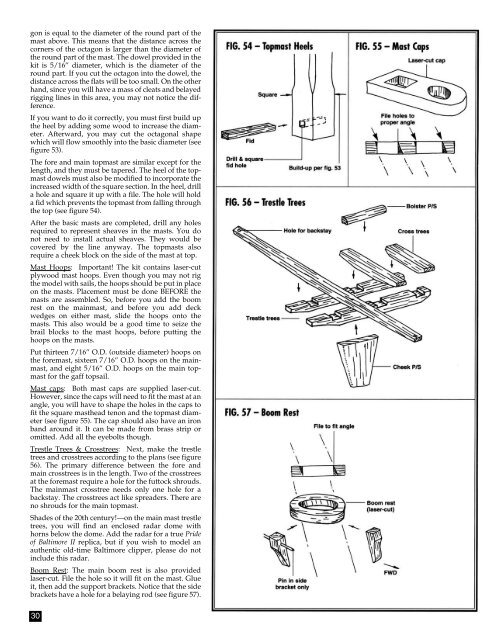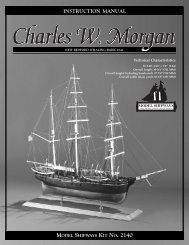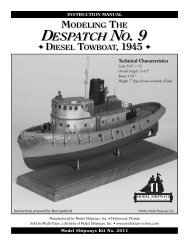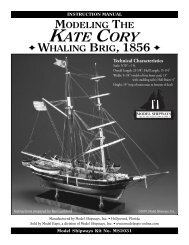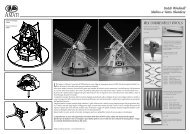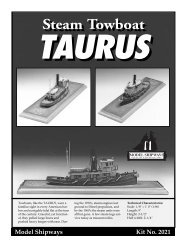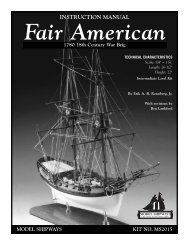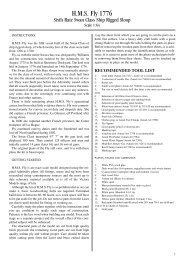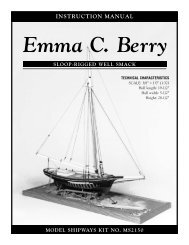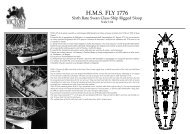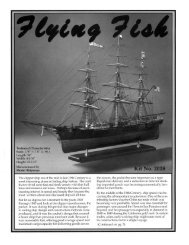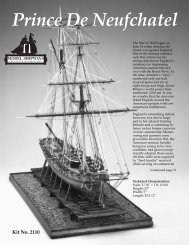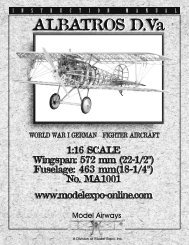download baltimore instruction manual
download baltimore instruction manual
download baltimore instruction manual
You also want an ePaper? Increase the reach of your titles
YUMPU automatically turns print PDFs into web optimized ePapers that Google loves.
gon is equal to the diameter of the round part of the<br />
mast above. This means that the distance across the<br />
corners of the octagon is larger than the diameter of<br />
the round part of the mast. The dowel provided in the<br />
kit is 5/16” diameter, which is the diameter of the<br />
round part. If you cut the octagon into the dowel, the<br />
distance across the flats will be too small. On the other<br />
hand, since you will have a mass of cleats and belayed<br />
rigging lines in this area, you may not notice the difference.<br />
If you want to do it correctly, you must first build up<br />
the heel by adding some wood to increase the diameter.<br />
Afterward, you may cut the octagonal shape<br />
which will flow smoothly into the basic diameter (see<br />
figure 53).<br />
The fore and main topmast are similar except for the<br />
length, and they must be tapered. The heel of the topmast<br />
dowels must also be modified to incorporate the<br />
increased width of the square section. In the heel, drill<br />
a hole and square it up with a file. The hole will hold<br />
a fid which prevents the topmast from falling through<br />
the top (see figure 54).<br />
After the basic masts are completed, drill any holes<br />
required to represent sheaves in the masts. You do<br />
not need to install actual sheaves. They would be<br />
covered by the line anyway. The topmasts also<br />
require a cheek block on the side of the mast at top.<br />
Mast Hoops: Important! The kit contains laser-cut<br />
plywood mast hoops. Even though you may not rig<br />
the model with sails, the hoops should be put in place<br />
on the masts. Placement must be done BEFORE the<br />
masts are assembled. So, before you add the boom<br />
rest on the mainmast, and before you add deck<br />
wedges on either mast, slide the hoops onto the<br />
masts. This also would be a good time to seize the<br />
brail blocks to the mast hoops, before putting the<br />
hoops on the masts.<br />
Put thirteen 7/16” O.D. (outside diameter) hoops on<br />
the foremast, sixteen 7/16” O.D. hoops on the mainmast,<br />
and eight 5/16” O.D. hoops on the main topmast<br />
for the gaff topsail.<br />
Mast caps: Both mast caps are supplied laser-cut.<br />
However, since the caps will need to fit the mast at an<br />
angle, you will have to shape the holes in the caps to<br />
fit the square masthead tenon and the topmast diameter<br />
(see figure 55). The cap should also have an iron<br />
band around it. It can be made from brass strip or<br />
omitted. Add all the eyebolts though.<br />
Trestle Trees & Crosstrees: Next, make the trestle<br />
trees and crosstrees according to the plans (see figure<br />
56). The primary difference between the fore and<br />
main crosstrees is in the length. Two of the crosstrees<br />
at the foremast require a hole for the futtock shrouds.<br />
The mainmast crosstree needs only one hole for a<br />
backstay. The crosstrees act like spreaders. There are<br />
no shrouds for the main topmast.<br />
Shades of the 20th century!––on the main mast trestle<br />
trees, you will find an enclosed radar dome with<br />
horns below the dome. Add the radar for a true Pride<br />
of Baltimore II replica, but if you wish to model an<br />
authentic old-time Baltimore clipper, please do not<br />
include this radar.<br />
Boom Rest: The main boom rest is also provided<br />
laser-cut. File the hole so it will fit on the mast. Glue<br />
it, then add the support brackets. Notice that the side<br />
brackets have a hole for a belaying rod (see figure 57).<br />
30


